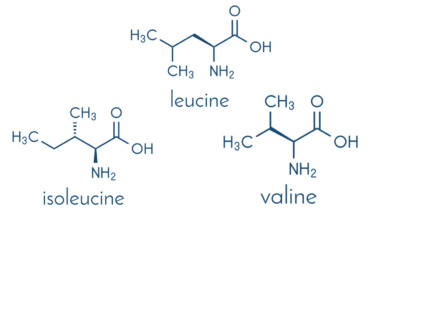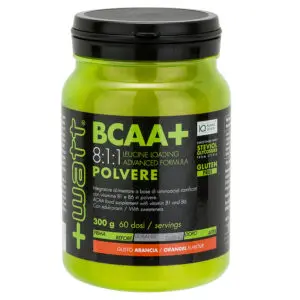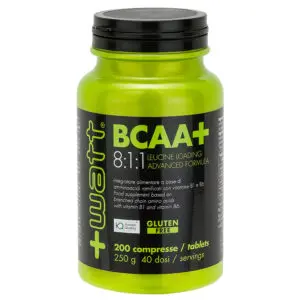BCAAs: which to choose and why?
The first food supplements with Branched Amino Acids (BCAAs), respectively L-Leucine, L-Isoleucine and L-Valine, were in the formulas 2:1:1, namely the quantity of L-Leucine is twice the quantity of L-Valine and that of L-Isoleucine.
This was due to the fact that human proteins have an average composition in which this relationship is present: indeed, by a quick computation, we can find out that our proteins are composed by two molecules of L-Leucine every one molecule of L-Valine, and the same ratio is present between L-Leucine and L-Isoleucine.
More recently, the formula with a greater contribution of L-Leucine (for example, BCAAs 8:1:1 with L-Leucine eight times as much as the quantity of L-Valine and that of L-Isoleucine) was born. This is explained by one of the BCAAs main functions, nowadays demonstrated and characterized in many molecular details by a very large amount of independent studies, namely their ability to stimulate the construction of new proteins (protein anabolism) in the skeletal muscle tissue (Buse, 1981, Horm Metab Res).
This effect, much exploited by athletes wanting to increase their muscle mass or simply by those wanting to preserve lean mass and recover from training effectively, depends largely on the activation of a multi protein complex called mTORC1 (mammalian Target Of Rapamycin Complex 1), also known simply as mTOR, within the muscle cell. mTOR, once activated by the BCAAs, controls a whole series of physiological responses leading to the synthesis of new proteins and muscle growth (Dodd & Tee, 2012, Am J Physiol Endocrinol Met).
More recent is the discovery that, among the three BCAAs, L-Leucine is the strongest activator of mTOR. Here is the idea behind the formula of the BCAA 8:1:1. Greater L-Leucine for greater mTOR activation.
Is therefore the BCAA 2:1:1 formula worse? It depends…
It depends on what the purpose of supplementation with the BCAAs is. Indeed, the latter not only stimulate protein anabolism, but have also very important activities, namely they reduce the sense of fatigue in the brain and can also be used as alternative energy source in prolonged and exhausting efforts!
If an athlete’s aim is to exploit these effects, probably the most balanced formula 2: 1: 1 is to be preferred. But if the aim is the building of new muscle fibers and / or the increase of muscle mass by stimulation of mTOR, then it is advisable to go up with L-Leucine and go towards the BCAA 8:1:1 formula.
Available research is increasingly supporting this thesis, so much so that many researchers in the field suggest the concept of ‘L-Leucine threshold’, namely that only when a certain minimum amount of L-Leucine reaches the muscular intracellular enviroment, it succeeds in giving the anabolic stimulus, activating mTOR. This implies that only when a BCAA supplement (or a protein source) has a high percentage of L-Leucine can give a good anabolic stimulus in the post-workout, obviously acting in synergy with the training itself (Phillips, 2014, Sports Med). In this light, the most recent formulation of the BCAA 8:1:1 allows the reachment of the ‘L-Leucine threshold’ easier.
With this regard, it must be mentioned another role of BCAAs, namely the defense from muscular catabolism.
Indeed, muscle mass is not only regulated by protein anabolism, but also by protein catabolism, which is the destruction of proteins occurring in muscle tissue during the workout. Scientific research has now clearly shown that oral supplementation with BCAAs prior to exercise protects the muscle cell from protein loss, as L-Leucine, once within the cell, is partly converted to another molecule, ß-hydroxy ß-methylbutyrate (HMB). HMB is a strong anti-catabolic agent which protects muscle fibers from mechanical stress induced by training (Wilkinson, 2013, J Physiol).
Therefore, also in this case the greater L-Leucine contained in the BCAA 8:1:1 formula is definitely advantageous as it allows a greater contribution of HMB and thus a greater attenuation of muscular catabolism induced by exercise.
However, it is not necessary to increase too much the relative quantity of L-Leucine. Indeed, the scientific studies have shown that athletes supplemented with BCAAs showed greater activation of protein synthesis than those supplemented with L-Leucine alone. This means that L-Leucine, despite being the most important, works in synergy with the other two BCAAs to better induce its anabolic effect.
+Watt Advice
Summarizing: the choice of the BCAA formula depends much on the athlete’s goal. A more balanced formula (2:1:1) should be opted before long workouts to exploit the potential for alternative energy source, while a formula with higher contribution of L-Leucine (8:1:1) will be the ideal choice for those wanting to increase their muscle mass.
Noteworthy, the three BCAAs are not enough to build our muscle proteins! All 20 proteinogenic amino acids are needed! It is important to ensure the sufficient amount of all these amino acids with a source of high biological value proteins.





